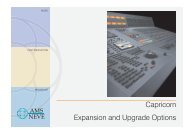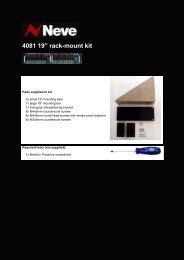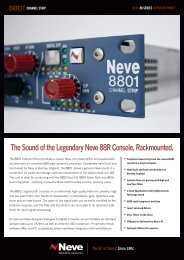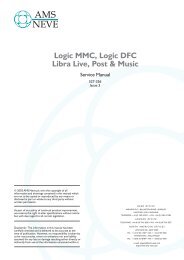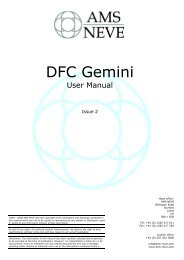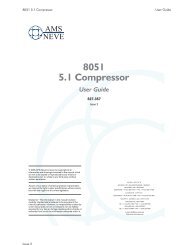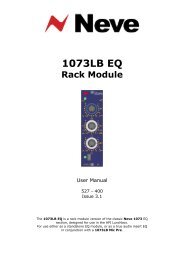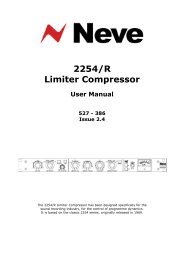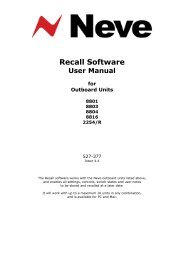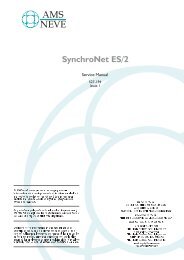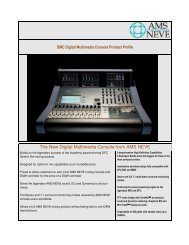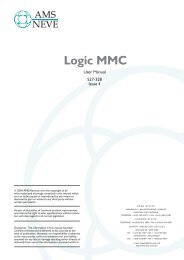Create successful ePaper yourself
Turn your PDF publications into a flip-book with our unique Google optimized e-Paper software.
An Overview of the <strong>Genesys</strong> Signal Flow<br />
Traditionally, mixing consoles are either Split or Inline monitoring design:<br />
• A Split console has a number of input channels, and has a separate<br />
monitor mix panel elsewhere on the control surface.<br />
• An Inline console has a Monitor path input on each Channel input<br />
fader strip. In this way, a 24-fader <strong>Genesys</strong> also has another 24<br />
Monitor inputs, in effect turning it into a 48-input desk.<br />
An Inline console incorporates multitrack (DAW) monitoring into the<br />
channel strips, so each channel strip has both an input signal path and a<br />
monitor signal path.<br />
<strong>Genesys</strong> is an Inline mixing console – this means it has both Channel<br />
input and Monitor input paths in each channel strip, with an trim control<br />
for each path (+/-15dB).<br />
Historically, the Monitor path was used to send and return to an analogue<br />
tape machine, but these days this is more likely to be a Digital Audio<br />
Workstation, such a Pro Tools, Nuendo, Cubase etc.<br />
This means there are two main sources of sound in the studio - one is<br />
from the musicians you are recording, the other from the tracks already<br />
recorded on your multitrack tape or DAW (these have a 'Send To' and a<br />
'Return From' path, either one of which can be listened to).<br />
• When Recording with <strong>Genesys</strong>, the Channel path is used for sending<br />
Microphones or line sources to the DAW/Tape Machine, and the<br />
monitor path is used for listening to the output of the DAW/Tape<br />
Machine.<br />
Having these two paths in each Input module allows you to have fader<br />
control of the recording and to use the monitor path fader to start a<br />
rough mix at the same time.<br />
• When Mixing with <strong>Genesys</strong> the Channel path becomes your first<br />
series of returns from the DAW to the console and the Monitor path via<br />
I/P2 allows more inputs to be brought back into the mix.<br />
For example a 16 fader <strong>Genesys</strong> when mixing allows 32 inputs to the<br />
mix buss for mixing, 16 inputs on the channel path and 16 inputs on<br />
the monitor path.<br />
You will need to be able to listen to all the individual channels and tracks<br />
that form the input and the monitor signals on your control room<br />
loudspeakers.<br />
On the Monitor Panel, when in Routing mode, you can send either the<br />
Channel (CH) path or Monitor (MON) path of each input to the L and/or R<br />
of the Main Mix.<br />
As an example, let's look at Channel Strip 1...<br />
The channel input path will take the signal from the selection knob at the<br />
top of the strip, either the Mic or Line (plugged directly into the rear of<br />
each channel strip), or the DAW or DLN (Digital Line Input, which<br />
requires the optional digital card) These last two options take their input<br />
via a D-type connector, 1 per 8-fader section.<br />
This selection is made pressing the knob itself and cycling through the<br />
options, the selection being displayed with the adjacent leds (this knob<br />
also provides +/15dB of input trim).<br />
The level control for this signal is via the fader.<br />
(All the other channel strip inputs perform exactly the same function).<br />
Channel Strip 1 will also have a Monitor path for Track 1 from the<br />
multitrack recorder or DAW. This is an entirely separate signal path from<br />
the Channel input.<br />
- 35 -




